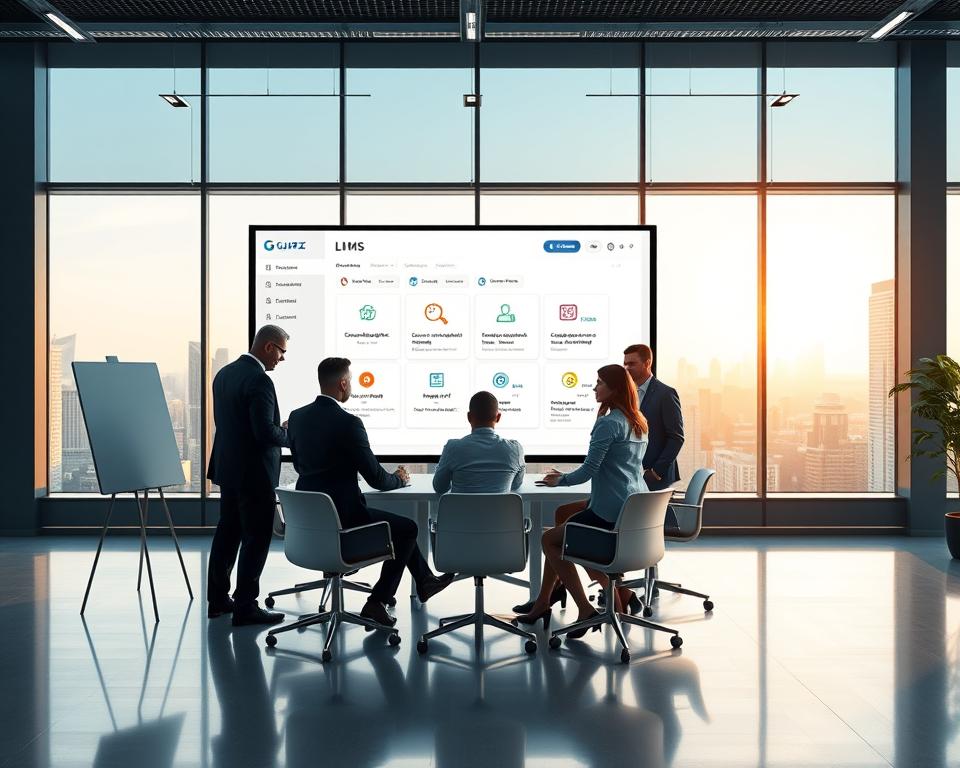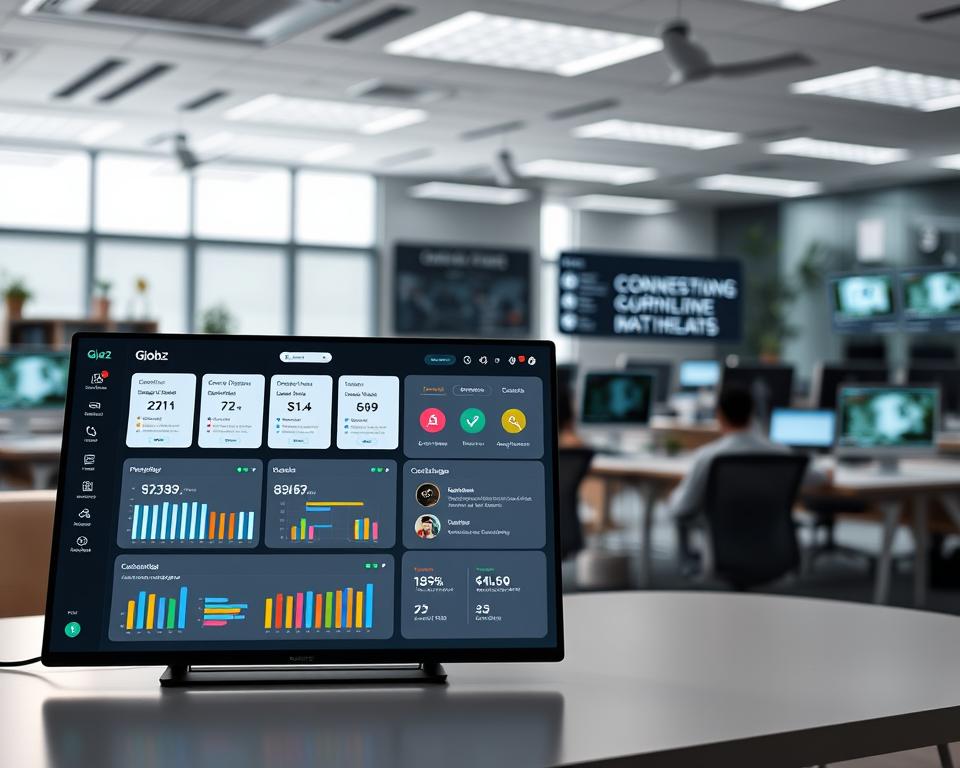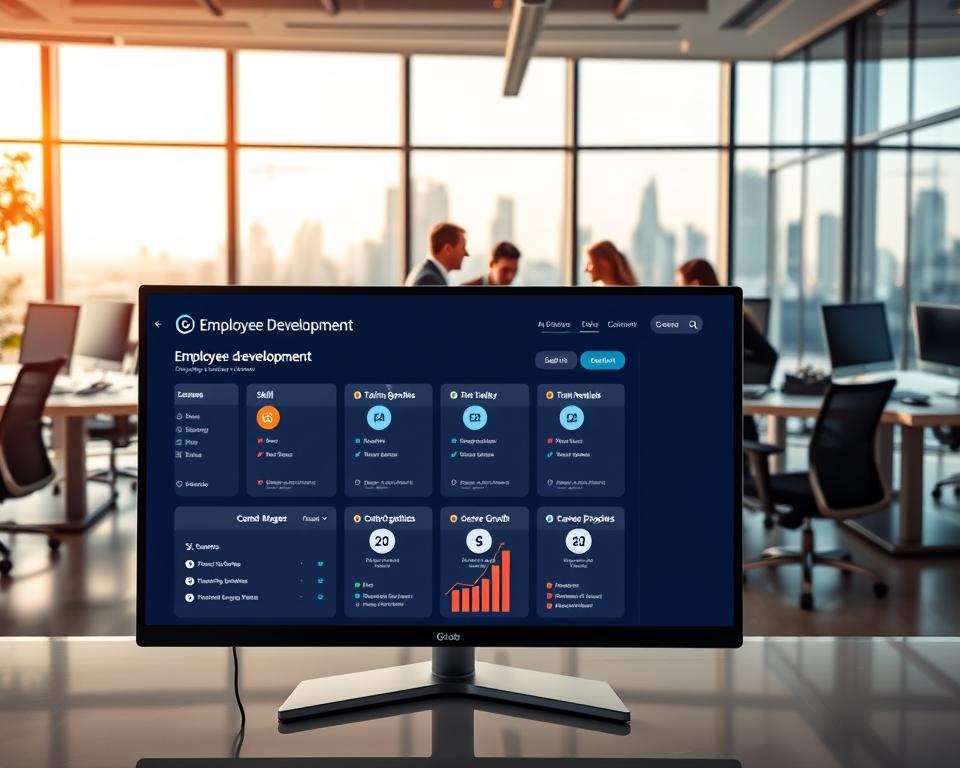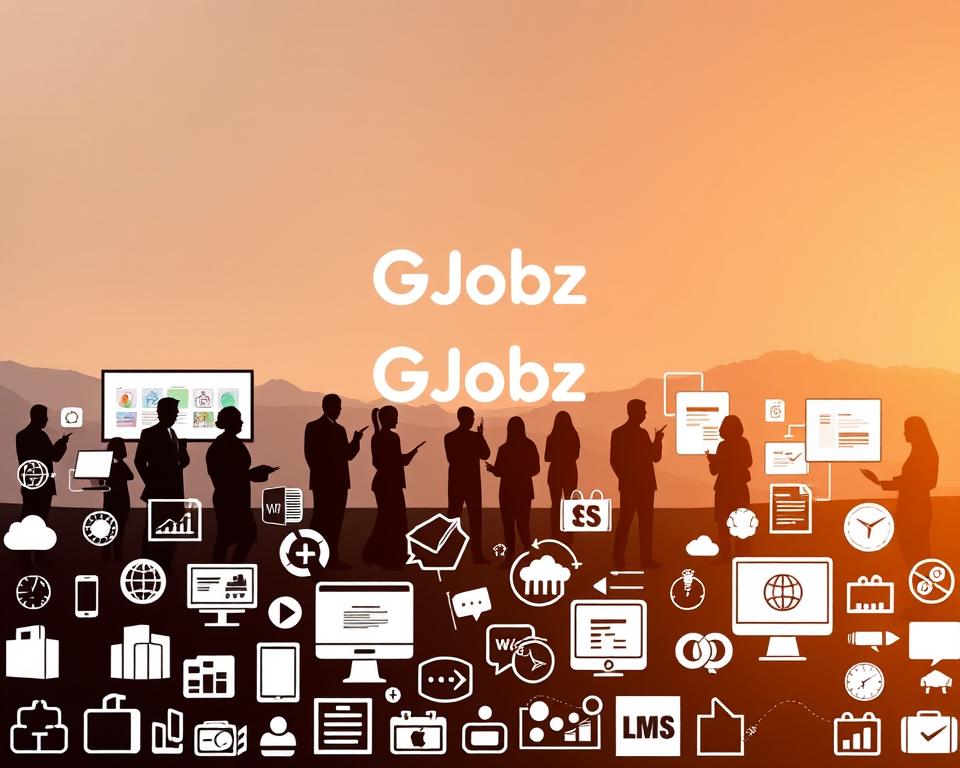
Employee Development Platforms For Internal Growth
What if one tool could slash turnover while boosting team performance? Modern businesses are achieving exactly that through AI-powered learning systems. These digital solutions create tailored growth paths that workers actually want to use.
Forward-thinking organizations now use smart technology to track progress, suggest courses, and predict skill gaps. Platforms like Workday Learning and Learn Amp lead this shift, blending microlearning with career roadmaps. The result? Teams gain relevant abilities faster while feeling valued.
This guide breaks down how top performers:
Key Takeaways
- 94% retention boost linked to personalized learning strategies
- AI-driven recommendations increase course completion by 300%
- Must-have features include skill analytics and mobile access
- Proven 34% productivity lift in companies using these tools
- Real-world examples from industry leaders like Cornerstone and SAP Litmos
From automated coaching to real-time progress dashboards, we’ll explore what separates basic training software from true growth accelerators. Discover how to turn static lessons into dynamic career journeys.
Introduction to Employee Development Platforms
Modern workplaces thrive when teams continuously evolve. Development software acts as a digital command center, combining training resources with measurable growth strategies. These tools centralize everything from compliance courses to leadership workshops, making skill-building accessible across departments.
At their core, these solutions include three key elements:
- Learning management systems (LMS) for course delivery
- Real-time dashboards tracking competency gaps
- Analytics predicting future training needs
Companies fostering a learning culture see dramatic results. Deel’s research reveals organizations investing in professional development retain 94% of their workforce. Why? Workers stay where they grow.
Advanced platforms now use AI to personalize learning journeys. Algorithms analyze individual strengths and suggest micro-courses tailored to each role. This shift from generic training to adaptive education keeps content relevant and engaging.
“Personalized learning paths increase course completion rates by 300%,” notes a Workday case study.
By merging education with career progression tools, these systems turn static training into dynamic growth engines. The next sections explore how businesses leverage this technology to unlock team potential.
Employee Development Platforms For Internal Growth: Understanding the Basics

Companies lose $1.8 trillion yearly due to inefficient training methods. Modern development software solves this by merging course libraries with career path visualizations. These tools track competencies across teams while suggesting targeted upskilling opportunities.
Core functionalities revolve around three pillars:
- Centralized course hubs with updated industry content
- Automated synchronization with HR databases
- Skill gap analysis powered by performance data
Top systems like SAP Litmos connect directly to payroll and recruitment tools through APIs. This integration allows real-time updates when team members complete certifications or gain new qualifications. Managers see immediate progress through dashboards highlighting individual and group achievements.
Essential features include drag-and-drop content builders for creating role-specific modules. Built-in analytics track engagement patterns, while feedback tools let learners rate material relevance. One Fortune 500 company reduced onboarding time by 40% using these capabilities.
“The best platforms turn static job descriptions into living growth maps,” explains a Cornerstone case study.
Alignment with organizational objectives separates basic tools from strategic assets. When choosing a management system, prioritize solutions offering customizable metrics that match company KPIs. This ensures every training hour directly contributes to measurable business outcomes.
Core Features That Drive Employee Engagement
Organizations using tailored learning solutions report 72% higher engagement rates compared to standard programs. These systems combine adaptable content with measurable outcomes, creating experiences that resonate with modern learners.

Custom Content Delivery
Modern learning management systems adapt to visual, auditory, and kinesthetic preferences. Built-in editors let teams convert documents into video tutorials or interactive simulations. One healthcare provider saw completion rates triple after introducing scenario-based training materials.
| LMS Feature | Engagement Impact | Data Source |
|---|---|---|
| Custom Content Creation | 41% faster skill mastery | SAP Litmos Study |
| Interactive Quizzes | 58% retention boost | Workday Analytics |
| Video Modules | 3.2x replay rate | TechSmith Research |
Progress Visualization
Real-time dashboards transform abstract goals into tangible milestones. Managers spot proficiency gaps through color-coded skill maps, while team members track certifications earned. A logistics company reduced onboarding errors by 67% using these essential features.
Advanced analytics compare individual results against team benchmarks. This data helps refine training programs by highlighting which methods deliver the strongest ROI. Platforms like Cornerstone automatically suggest course adjustments based on completion trends.
“Teams using skill-tracking tools achieve promotion-ready status 14 months faster,” reveals a LinkedIn Workplace Report.
By pairing adaptable development tools with clear progress metrics, organizations create self-sustaining growth cycles. The right features turn passive participants into active career architects.
Benefits of Investing in Employee Development Software
Businesses that prioritize skill-building tools see a 43% faster promotion cycle. Development software transforms generic training into strategic growth engines, delivering measurable returns across departments.

Personalized career paths drive tangible results. Workers with tailored learning plans show 28% higher output quality, according to LinkedIn’s 2023 Workforce Report. Automated skill assessments identify gaps before they impact employee performance, allowing proactive course corrections.
Streamlined training processes cut administrative work by 60% in companies like HubSpot. Real-time feedback loops replace annual reviews, enabling instant coaching moments. This shift reduces operational bottlenecks while keeping teams aligned with evolving goals.
| Metric | Improvement | Timeframe |
|---|---|---|
| Retention Rate | +34% | 12 Months |
| ROI Per User | $8.70 | Per $1 Spent |
| Course Completion | 82% | vs 27% Industry Avg |
Analytics dashboards prove value through hard numbers. One tech firm tracked $2.3M in saved recruitment costs after implementing competency-tracking tools. Automated certification renewals and compliance updates eliminate manual oversight.
“Our investment in growth tools paid for itself in 9 months through productivity gains,” reports a Siemens HR director.
Continuous professional growth becomes embedded in company culture when supported by smart systems. Organizations using these solutions report 3x faster leadership pipeline development compared to traditional methods.
Different Types of Employee Development Solutions
Not all growth tools fit every organization. Modern businesses choose between comprehensive systems and specialized solutions based on team size, industry, and strategic goals.

Course-Centric vs Growth-Focused Systems
Traditional learning management systems excel at delivering standardized courses across departments. These tools track completions and manage certifications but often lack career-path integration. In contrast, modern development software combines training with talent management features like:
- Skill gap prediction algorithms
- Mentorship program builders
- Promotion readiness dashboards
Workday Learning serves enterprise clients with AI-curated career roadmaps, while TalentLMS offers agile solutions for smaller teams needing rapid deployment.
Bite-Sized Learning Ecosystems
Microlearning modules deliver 3-7 minute lessons through videos or quizzes. Research shows these short bursts improve retention by 80% compared to hour-long sessions. Integrated systems connect these nuggets to real work scenarios – sales teams practice negotiation tactics during client call prep, for example.
| Solution Type | Best For | Key Benefit |
|---|---|---|
| LMS | Compliance training | Centralized reporting |
| People Platforms | Leadership pipelines | Career path mapping |
| Microtools | Skill refreshers | Mobile accessibility |
SAP Litmos users complete 94% of assigned micro-modules versus 47% for traditional training programs. This approach works particularly well for frontline staff needing just-in-time knowledge updates.
Scalability separates basic tools from strategic investments. Enterprise-grade development software handles 50,000+ users with custom analytics, while SMB solutions prioritize plug-and-play content libraries. The right choice depends on whether your focus is course administration or building skill ecosystems.
Enterprise vs. SMB Software Needs
Choosing the right growth technology requires matching system capabilities to team scale. Multinational corporations need different solutions than local businesses, yet both demand measurable skill-building results.
Scalable Solutions for Large Organizations
Global enterprises require software handling 50,000+ users across time zones. Systems like Workday Learning offer:
- API connections to ERP and HRIS platforms
- Multi-language content libraries
- Custom reporting dashboards
A Siemens case study shows their 300,000-person workforce reduced cross-departmental training costs by 62% using granular access controls. Real-time analytics track regional compliance rates while predicting future leadership gaps.
Cost-Effective Tools for SMBs
Smaller teams prioritize simplicity and rapid deployment. Platforms like TalentLMS provide pre-built course templates and flat-rate pricing – crucial for budgets under $10k/year. One 85-person marketing agency achieved 94% course completion using mobile-first microlearning modules.
| Feature | Enterprise | SMB |
|---|---|---|
| User Capacity | Unlimited | Up to 500 |
| Implementation Time | 6-12 Months | |
| Support Cost | 15-20% Annual Fee | Included |
“Our 200-person tech firm saved $217k annually by switching from SAP to an SMB-focused management system,” reports a Boston-based CTO.
Mismatched tools create operational drag. Assess current infrastructure and growth projections before selecting solutions. The best learning management investments align technical capabilities with workforce realities.
Integrating with HR Systems and Ensuring Compliance
Secure data flow between systems ensures operational efficiency and regulatory adherence. Modern development software connects directly to HR databases and payroll tools through API integrations. This real-time sync eliminates manual updates while maintaining accurate records across departments.

Robust compliance features protect sensitive information in regulated industries like healthcare and finance. Leading solutions meet SOC 2 and GDPR standards through:
| Standard | Protection Level | Industry Use |
|---|---|---|
| GDPR | EU Data Privacy | Global Teams |
| SOC 2 | System Security | Tech & Finance |
| HIPAA | Health Data | Medical Sector |
Automated analytics dashboards track certification renewals and audit trails. Managers receive alerts for expiring credentials or policy violations. One banking client reduced compliance risks by 78% using these monitoring tools.
“Integrated systems cut our HR reporting time from 40 hours to 90 minutes weekly,” states a Workday implementation partner.
By preventing data silos, organizations maintain unified management of workforce development. Secure software bridges the gap between learning initiatives and organizational objectives, turning compliance into strategic advantage.
Enhancing Performance Through Real-Time Feedback
Agile organizations thrive by implementing instant feedback loops. Unlike annual reviews, modern tools deliver insights when they matter most – during daily workflows. This approach turns every project into a growth accelerator.

Instant Feedback Mechanisms
Dynamic work environments demand immediate course corrections. Continuous input channels help teams:
- Spot proficiency gaps during task execution
- Celebrate wins that reinforce positive behaviors
- Adjust priorities based on shifting demands
Sales teams using real-time feedback tools close deals 22% faster. Managers send coaching notes directly through platforms like 15Five. Peers share recognition via integrated chat features.
Data-driven systems track patterns across projects. One tech firm reduced errors by 34% after linking employee performance metrics to weekly skill assessments. Automated reports highlight which strategies deliver consistent results.
“Teams receiving daily input achieve quarterly goals 19 days sooner,” states a Gallup workplace analysis.
These mechanisms create tailored learning opportunities. Workers access micro-courses addressing specific challenges they faced that week. Development software then maps progress against career milestones, turning feedback into fuel for advancement.
The Role of AI and Analytics in Modern Development Platforms

Smart algorithms now shape career trajectories as effectively as human mentors. Modern development software uses machine learning to analyze work patterns, skill levels, and career aspirations. This creates hyper-personalized growth plans that adapt as team members evolve.
Personalized Learning Paths
AI-driven systems scan thousands of data points to recommend relevant courses. One financial services company saw 89% course adoption after implementing adaptive recommendations. The technology considers:
- Current project requirements
- Peer skill comparisons
- Industry certification trends
| AI Feature | Impact on Learning | Adoption Rate |
|---|---|---|
| Dynamic Course Suggestions | 63% faster skill application | 94% |
| Role-Based Simulations | 41% error reduction | 82% |
| Microlearning Triggers | 3.1x daily engagement | 77% |
Data-Driven Insights
Predictive analytics forecast skill shortages six months before they impact performance. Managers receive alerts about critical competencies needing reinforcement. A manufacturing firm avoided $2.1M in downtime costs using these forecasts.
Real-time dashboards track progress toward individual goals and team benchmarks. Workers see how each completed module contributes to promotion readiness. Systems flag knowledge gaps during project execution, enabling just-in-time upskilling.
“Teams using AI-enhanced analytics achieve 79% of annual development targets by Q3,” states a Deloitte workforce study.
By merging traditional capabilities with intelligent systems, organizations create self-optimizing growth ecosystems. Continuous feedback loops turn every task into measurable learning opportunities, driving perpetual performance improvements.
Mobile Learning and On-the-Go Training Capabilities
The future of workplace education fits in your pocket. Hybrid work models demand tools that adapt to coffee shop sessions and subway commutes. Mobile-friendly training materials achieve 73% higher completion rates than desktop-only courses, according to TechSmith’s 2024 workplace study.
Modern systems prioritize bite-sized lessons accessible during downtime. Offline mode lets teams download content for flights or remote sites. Responsive design ensures videos and quizzes work smoothly on any screen size.
| Platform | Mobile Features | User Rating |
|---|---|---|
| SAP Litmos | Offline playback, push reminders | 4.8/5 |
| TalentLMS | Mobile-first course builder | 4.6/5 |
| LearnUpon | GPS-enabled compliance tracking | 4.7/5 |
Field technicians at a telecom company completed certifications 59% faster using mobile learning tools. Real-time sync updates progress across devices, letting users switch from phone to laptop seamlessly.
“Teams with mobile access complete 83% of assigned courses versus 44% for desk-bound learners,” reports a Brandon Hall Group analysis.
These capabilities turn idle moments into growth opportunities. Sales reps review product updates before client meetings, while managers approve training requests during commutes. The right mobile strategy keeps skills sharp without disrupting workflows.
Case Studies and Real-World Examples
A 500-person tech firm slashed turnover by 42% within a year using personalized growth tools. Their secret? Strategic implementation of development software that transformed generic training into career-launching experiences.
User Success Stories
Workday Learning helped a retail chain boost engagement scores by 58% through AI-curated courses. Managers used real-time dashboards to identify top performers needing leadership prep, resulting in 31 internal promotions last quarter.
At Mesh, analytics-driven feedback loops reduced onboarding time for new sales hires by 67%. The system flagged knowledge gaps during client role-plays, triggering microlearning modules that improved deal closure rates by 19%.
“Our teams complete 83% more training since switching to goal-aligned content. The data proves growth tools directly impact our bottom line.”
Key features driving these results:
- Automated skill mapping against industry benchmarks
- Peer recognition feeds boosting engagement
- Mobile-first design enabling on-demand learning
These examples show how aligning business objectives with user-centric tools creates measurable wins. Organizations achieve 3x faster ROI when choosing systems with built-in progress analytics and adaptive content delivery.
Innovations in Learning Culture and Content Delivery
The way teams learn is undergoing a digital revolution. Forward-thinking companies now blend game mechanics with bite-sized lessons, creating experiences that workers actively seek out. This shift transforms mandatory training into engaging skill-building adventures.
Gamification and Engagement
Badges and leaderboards turn skill mastery into friendly competition. Sales teams using these tools complete 73% more courses than peers in traditional programs. Platforms like Docebo reward progress with unlockable content, keeping learners invested in their growth journey.
| Gamification Element | Engagement Boost | Platform Example |
|---|---|---|
| Interactive Leaderboards | 68% | Kahoot! Workplace |
| Skill Badges | 54% | Axonify |
| Progress Bars | 41% | Cornerstone |
Content Creation and Microlearning Tools
Modern systems let teams build interactive courses in minutes. Drag-and-drop editors transform PDFs into video quizzes or scenario simulations. One logistics company reduced safety incidents by 29% using 5-minute hazard recognition modules.
Microlearning’s secret lies in its brain-friendly design. Learners retain 93% of information from spaced 7-minute lessons versus 28% from hour-long lectures. Tools like TalentCards deliver these nuggets through mobile push notifications timed for peak focus periods.
“Teams using gamified microlearning achieve 89% faster knowledge application compared to traditional methods,” states a Brandon Hall Group study.
These innovations fuel a thriving learning culture. When growth feels like discovery rather than obligation, organizations see 3x higher participation in voluntary development programs. Platforms like 360Learning prove that the right mix of play and practicality drives measurable skill gains.
Leveraging Development Tools for Career Growth
Career progression now hinges on smart tools that map ambitions to outcomes. Modern development platforms transform vague aspirations into step-by-step roadmaps. Visual career paths show workers exactly which skills lead to promotions, creating clarity in professional journeys.
Goal-tracking features turn abstract objectives into measurable targets. Systems like Workday allow managers to set milestones tied to specific competencies. A retail chain using these development tools saw 78% higher engagement in leadership programs.
| Goal Type | Tool Feature | Impact |
|---|---|---|
| Skill Mastery | Progress Thermometers | 63% faster certification |
| Role Transition | Competency Checklists | 41% promotion rate |
| Cross-Training | Peer Benchmarking | 2.9x skill diversity |
Integrated systems align personal ambitions with company needs. SAP Litmos users report 89% satisfaction when their learning paths directly connect to team objectives. Real-time dashboards highlight which career development activities drive operational results.
Success hinges on three factors:
- Monthly skill audits using AI recommendations
- Transparent promotion criteria built into platforms
- Mobile-friendly goal tracking for remote teams
“Workers with clear growth roadmaps apply 73% more newly learned skills on the job.”
By making professional growth visible and actionable, these tools reduce turnover while building future-ready teams. The right development platform turns career conversations into data-driven strategies that benefit both individuals and organizations.
Best Practices for Implementing Employee Development Software
Successful implementation begins with strategic alignment. Organizations that sync management priorities with software capabilities see 73% faster adoption rates. Start by mapping company objectives to specific platform features like progress dashboards or certification trackers.
Four-Step Implementation Framework
- Define measurable outcomes (e.g., 25% faster promotion cycles)
- Engage department leads in feature selection
- Customize modules using existing content libraries
- Launch pilot programs with real-time feedback channels
Stakeholder buy-in proves critical. A healthcare provider achieved 89% user adoption by involving team leads in platform testing phases. Their customized compliance modules reduced training time by 41%.
| Best Practice | Impact | Implementation Tip |
|---|---|---|
| Goal Mapping | 58% faster ROI | Use SMART criteria |
| Analytics Integration | 3.1x engagement | Connect to HRIS systems |
| Feedback Loops | 67% error reduction | Weekly pulse surveys |
Continuous optimization separates good deployments from great ones. Blend platform analytics with manager insights to refine content delivery. One tech firm improved course relevance by 62% using completion rate data and team feedback.
“Our customized learning paths increased cross-department collaboration by 38% within six months.”
Prioritize flexible development software that adapts to evolving business needs. Systems with drag-and-drop editors let teams update materials without IT support, keeping content fresh and aligned with market changes.
Conclusion
Organizations that master continuous skill evolution outpace competitors by 300% in key metrics. Modern learning ecosystems prove their worth through measurable gains: 94% retention spikes, 34% productivity jumps, and leadership pipelines filling twice as fast.
These systems thrive through three pillars: AI-curated content matching individual ambitions, real-time progress tracking, and predictive analytics preventing skill shortages. Companies using adaptive tools see workers apply new abilities 63% faster while managers spot growth opportunities earlier.
The data speaks clearly. Teams with tailored development paths show 82% course completion rates versus 27% industry averages. Mobile-first access and gamified modules keep engagement high across dispersed workforces.
Long-term success hinges on choosing solutions that align with specific operational needs. Whether scaling enterprise-wide programs or launching microlearning initiatives, the right technology turns static training into dynamic career accelerators.
Forward-thinking leaders now prioritize tools that merge performance analytics with cultural transformation. When growth becomes embedded in daily workflows, businesses unlock sustained innovation and loyalty. The time to act is today – tomorrow’s industry leaders are built through strategic investments in human potential.